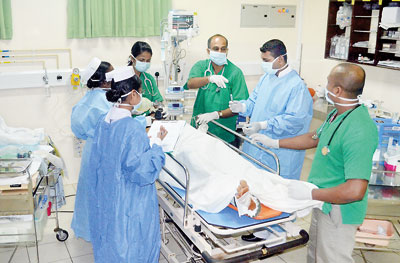Gearing to save more lives
Involved in an accident or emergency anywhere across the country, any man, woman or child would have the best chance of survival, with the development of services in state hospitals within the next five years. Thirty Accident and Emergency (A&E) Services are to be established in state hospitals island-wide from 2014 to 2018, the Sunday Times learns.

The A&E Service at Karapitiya Hospital
Measures are underway to establish policy followed by concrete steps not only to rush such patients through an emergency room but also for ‘triage’ through which the treatment of accident victims may be determined and prioritized based on the severity of their condition.
Currently what happens in many hospitals is that such patients go into the “cold” Outpatients Department (OPD) like any other patient. This could mean a life-and-death issue, points out the Deputy Director-General of Medical Services, Dr. Ananda Gunasekera who is the ‘focal point’ for the development of Accident and Emergency (A&E Services) at government hospitals.
A&E Services at present are available only at Kurunegala and Karapitiya Hospitals, with a few more such as Gampaha Hospital in the development stage. The spadework for the establishment of A&E Services across the country began last year, according to Dr. Gunasekera, with 20 rounds of discussions with eminent physicians, surgeons and anaesthetists to sort out overlapping areas. Thereafter, the doctors’ colleges, non-governmental organizations, the World Health Organization (WHO) and the World Bank sat down to discuss draft policy.
The “polishing” of the draft policy, before submission to Cabinet, took place during an exhaustive one-day conference on May 21 at the Cinnamon Grand Hotel where a Strategic Plan as well as a Manual with protocols for clinicians manning A&E Services was drawn up.
Referring to funding, Dr. Gunasekera said part of a US$ 200 million soft loan secured by the Health Ministry from the World Bank would be utilized to turn words into deeds.
Going into detail with regard to the ‘A&E Care Plan’, he spreads the bare bones on the table. There would be Apex A&E Centres for each province, with “proper” A&E systems up to base hospital level, Emergency Room facilities for all hospitals below that, introduction of pre-hospital care with the existing ambulance fleet and also the training of the public on basic life support methods, so that they could keep victims alive until an ambulance reaches them.

Under the proposed scheme there would be three levels of A&E Services, he explains, adding that any hospital which has Specialists is entitled to have an A&E Service.
Teaching Hospitals, Provincial General Hospitals (each of the nine provinces has one), District General Hospitals and Base Hospitals have Specialists while District, Peripheral and Rural Hospitals have only visiting Specialists and Central Dispensaries at grassroots level have an OPD.
The Provincial General Hospitals and the Teaching Hospitals considered the Apex Hospitals with all facilities will have A&E Service I, the highest level; with District General Hospitals A&E II; and Base Hospitals A&E III. The A&E Service gets scaled as it goes down the line, says Dr. Gunasekera, pointing out that the next issue that they had to look at was how accident or emergency victims could be brought to hospital.
The answer would be an efficient emergency ambulance system, the Sunday Times learns. There are 300 ambulances around the country in the state system, 250 more have just been added to this fleet while 200 more would be provided shortly, he says, adding that the A&E Services project got off the ground due to the unstinting support extended by Health Ministry Secretary Dr. Nihal Jayathilake and the assistance of the Director-General of Health Services, Dr. Palitha Mahipala; the Director of Medical Services, Dr. Lal Panapitiya; Karapitiya Emergency Physician, Dr. Aruna Munasinghe; the Director of the Matara Hospital, Dr. S. Samarakoon; and the Prof. of Surgery of the Sri Jayewardenepura Medical Faculty, Prof. Mohan de Silva.
The thinking behind an efficient ambulance service also includes coordination with Sri Lanka Telecom to provide a GPS tracking system, with each Apex Centre being the ‘Control Room’ with maps at hand of the area coming under them to direct the ambulances.
With implementation spread over five years, the vision of Dr. Gunasekera and the Health Ministry is to make Sri Lanka the country with the best emergency care service.
Pow wow on A&E policy
The main thrust of the one-day ‘Policy decisions/Strategic planning conference’ sponsored by the WHO was the establishment of Apex Centres and A&E Services at nominated priority state hospitals, while developing pre-hospital emergency care services such as cardiopulmonary resuscitation (CPR) training among the community, setting-up of hotlines and ambulance transportation services.
Among the 60 participants were high-level officials of the Health Ministry, Directors of major hospitals, clinical and academic experts and representatives of the WHO, professional colleges, Sri Lanka Medical Association, Government Medical Officers’ Association, armed services, Simulation Centre, Red Cross, St. John’s Ambulance and major private hospitals in Colombo.

Dr. Ananda Gunasekera addressing the conference
Many of the Strategic Objectives are directly linked to the development of an A&E Service and included hospital-based A&E and pre-hospital emergency care. While hospital A&E unit development will be by the Health Ministry, the pre-hospital care will involve the training and participation of the public, the Police and armed services, service organizations such as St. John’s Ambulance and Red Cross and telecommunication authorities.
The only invitee from outside Sri Lanka, the Charitable Health Fund of Melbourne, Australia, presented the document ‘Pre-hospital emergency care – a Melbourne perspective’. Noting the large number of lives lost before arrival at a hospital, trauma and coronary disease heading the list, its representative Dr. Ranjith Hettiarachi detailed a proposal to train the public in emergency care, setting up hotlines and answering services, ambulance services and liaison with a public hospital A&E.
The Charitable Health Fund was requested to assist St. John’s Ambulance in CPR & Basic Life Support training of the community.
Follow @timesonlinelk
comments powered by Disqus


